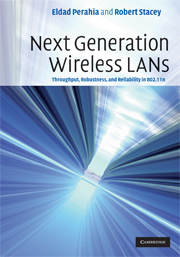Book contents
- Frontmatter
- Contents
- Foreword by Dr. Andrew Myles
- Preface
- List of abbreviations
- 1 Introduction
- Part I Physical layer
- Part II Medium access control layer
- 7 Medium access control
- 8 MAC throughput enhancements
- 9 Advanced channel access techniques
- 10 Interoperability and coexistence
- 11 MAC frame formats
- Part III Transmit beamforming
- Index
- References
7 - Medium access control
from Part II - Medium access control layer
Published online by Cambridge University Press: 04 December 2009
- Frontmatter
- Contents
- Foreword by Dr. Andrew Myles
- Preface
- List of abbreviations
- 1 Introduction
- Part I Physical layer
- Part II Medium access control layer
- 7 Medium access control
- 8 MAC throughput enhancements
- 9 Advanced channel access techniques
- 10 Interoperability and coexistence
- 11 MAC frame formats
- Part III Transmit beamforming
- Index
- References
Summary
The medium access control (MAC) layer provides, among other things, addressing and channel access control that makes it possible for multiple stations on a network to communicate. IEEE 802.11 is often referred to as wireless Ethernet and, in terms of addressing and channel access, 802.11 is indeed similar to Ethernet, which was standardized as IEEE 802.3. As a member of the IEEE 802 LAN family, IEEE 802.11 makes use of the IEEE 802 48-bit global address space, making it compatible with Ethernet at the link layer. The 802.11 MAC also supports shared access to the wireless medium through a technique called carrier sense multiple access with collision avoidance (CSMA/CA), which is similar to the original (shared medium) Ethernet's carrier sense multiple access with collision detect (CSMA/CD). With both techniques, if the channel is sensed to be “idle,” the station is permitted to transmit, but if the channel is sensed to be “busy” then the station defers its transmission. However, the very different media over which Ethernet and 802.11 operate mean that there are some differences.
The Ethernet channel access protocol is essentially to wait for the medium to go “idle,” begin transmitting and, if a collision is detected while transmitting, to stop transmitting and begin a random backoff period. It is not feasible for a transmitter to detect a collision while transmitting in a wireless medium; thus the 802.11 channel access protocol attempts to avoid collisions.
- Type
- Chapter
- Information
- Next Generation Wireless LANsThroughput, Robustness, and Reliability in 802.11n, pp. 181 - 202Publisher: Cambridge University PressPrint publication year: 2008
References
- 1
- Cited by



